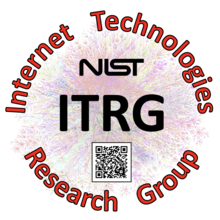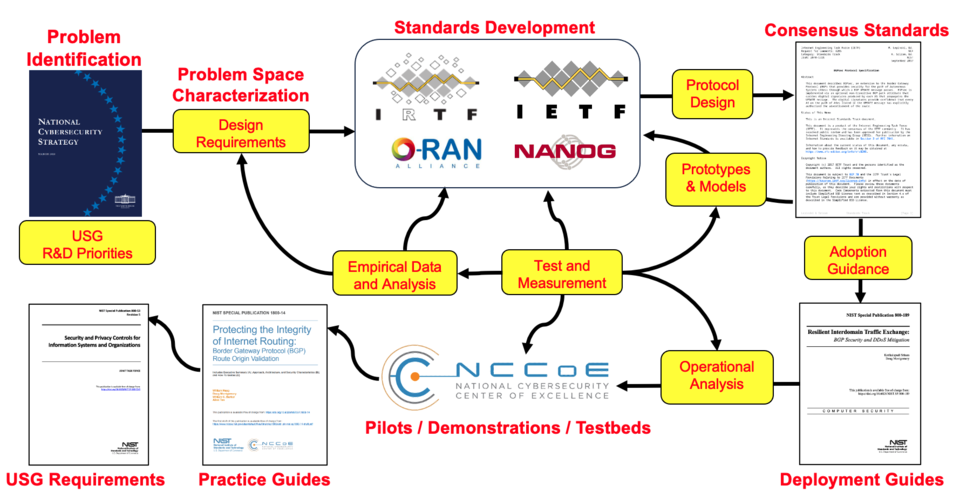Evolving the Technical Infrastructure of the Internet
Internet technologies provide a technical infrastructure for most of the systems (information, transportation, manufacturing, communications, defense, Government, education, entertainment, etc) that underlie our lives.
- The global Internet is at a crossroads as the viability of several of its most basic infrastructural technologies (routing, naming and addressing) are threatened by inherent vulnerabilities and robustness problems.
- Internet technologies provide the basis for networks of the future - including the Internet of Things, industrial control systems, advanced mobile broadband, cloud computing, etc. The pace of innovation in Internet technologies to address these new and disruptive use cases is rapid.

ITRG Mission:
- Fostering New Network Technology - The ITRG works with industry to improve the quality and timeliness of emerging specifications and to foster industry adoption of next-generation Internet technologies and distributed information systems.
- Advancing Network Metrology - The emphasis of the group is on innovating and applying advanced measurement science to increase the robustness and expand the applicability of potentially disruptive Internet technologies.
- Competencies of the group include: leadership in industry consensus standards, modeling and analysis of emerging Internet technologies, measurement science for scalable information systems, design and evaluation of advanced network test and measurement techniques, and rapid prototyping and empirical measurement of early protocol designs.
- Our efforts focuses on Internet Scale problems, solutions and measurement techniques.
ITRG Techniques / Competencies:
- Analytical, Simulation & Emulation Modeling.
- Internet scale modeling for performance, scalability, vulnerability, robustness.
- Protocol Design, Analysis and Standardization
- Internet Engineering Task Force (IETF), Internet Research Task Force (IRTF), North American Network Operators Group (NANOG), WiFi Alliance.
- Internet Scale Measurement and Data Analysis.
- Measurement and monitoring of Internet infrastructure.
- Collaboration with various large scale measurement activities.
- Rapid Prototyping.
- Open source reference implementations of emerging specifications.
- Deployment guidance and profiles.
- Fostering commercial adoption and deployment
- Test and Evaluation of Emerging Implementations
- Test tools designed to assist implementers and early adopters.
- Accredited testing laboratories for formal product interoperability and conformance.

ITRG Current Focus Areas:
ITRG's primary focus is upon Trustworthy Networks Research, where we work to establish the technical basis necessary to improve the security, resilience and performance of the communication infrastructures that underlie our network-centric society. Our research cultivates trust in current and emerging network technologies by developing and applying innovative measurement techniques, improving the quality and timeliness of consensus standards, and providing tools and guidance necessary to expedite adoption of advanced network technologies. ITRG collaborates directly with leading industry research (Internet Research Task Force), standards (Internet Engineering Task Force, O-RAN Alliance, ATIS) and network operations (North American Network Operators Group) communities to leverage NIST contributions and foster the design, standardization and commercial deployment of solutions to systemic vulnerabilities and robustness issues in existing and emerging core network infrastructure.
Current project areas within this program include:
- The Advanced Security Architectures for Next Generation Wireless project works with mobile wireless, internet and virtual computing industry to improve the security and resilience of emerging designs for 56 / 6G core networks and radio access networks (RANs). Our current work focuses on enhancing the security properties of emerging O-RAN Alliance standards for 5G Open-RAN and disaggregated virtualize core networks.
- The Zero Trust Networks project seeks to define the basic principles of zero trust architectures and to develop standards and guidance for their implementation in modern enterprise environments and in the core infrastructure of next generation wireless networks.
- The Robust Inter-Domain Routing project includes collaborative research with leading Internet companies to design and standardize technologies to improve the resilience and security of the Internet’s global routing system. It focuses on developing and fostering deployment of mitigation techniques for attacks and misconfigurations that result in large-scale Internet outages.
- The Trustworthy Intelligent Networks project works with industry and academia to improve the trustworthiness and applicability of artificial intelligence and machine learning technologies to future networks and distributed systems. Our research focuses on applications of AI/ML to address security and robustness issues today's networks and developing means to test and measure the robustness of AI/ML techniques necessary for future autonomic networks.
- The High Assurance Domains project works with the IETF, Messaging Malware Mobile and Anti-Abuse Working Group (MAAWG), Department of Defense and the Federal CIO Council to research and develop new technologies to address key trust and security issues in enterprise networks. The current focus of this effort is on the development of a reference architecture and evaluation techniques for emerging Zero Trust Networks.
- The Software Defined and Virtual Networks project works to develop test and measurement techniques to advance the state of the art in network virtualization, network service function chaining, software defined networks, technologies and techniques to address robustness and security of virtualized network services. Our work explores novel applications of NFV/SDN to domains such as network security and intrusion detection, support of machine to machine communications, support of advanced mobility and cloud computing. A key component of this research is the development of enabling programmable measurement techniques that can efficiently operate at the scale and speed of advanced networks.
- The Trustworthy Network of Things project works with industry to design, standardize, test and foster adoption of network-centric approaches to protect IoT devices from the Internet and to protect the Internet from IoT devices. Our current efforts focus on the research and development manufacturer usage description (MUD) and secure device onboardings technologies.
- The USGv6 Program works with the IETF and Federal CIO community to provide technical leadership in standards profiles, product testing programs, and deployment guidance to foster the global transition to the next generation Internet Protocol (IPv6).
- The Measurement Science for Complex Information Systems project aims to develop and evaluate a coherent set of methods to understand behavior in complex information systems, such as the Internet, computational grids and computing clouds. Such large distributed systems exhibit global behavior arising from independent decisions made by many simultaneous actors, which adapt their behavior based on local measurements of system state. Actor adaptations shift the global system state, influencing subsequent measurements, leading to further adaptations. This continuous cycle of measurement and adaptation drives a time-varying global behavior. For this reason, proposed changes in actor decision algorithms must be examined at large spatiotemporal scale in order to predict system behavior.
Please see each project for details of our contributions including research publications, standards specifications, software tools, guidance documents, workshops, etc.
News and Updates
Recent Software
Awards and Recognition
- NIST IPv6 Deployment Monitor and Test Tool. - http://fedv6-deployment.antd.nist.gov/
- NIST RPKI Monitor - http://rpki-monitor.antd.nist.gov/
- NIST BGP Secure Routing Extension (BGP‑SRx) Software Suite - https://www.nist.gov/services-resources/software/bgp-secure-routing-extension-bgp-srx-software-suite
Contacts
ITRG Information Contact:
-
(301) 975-3630
-
ITRG Contact









